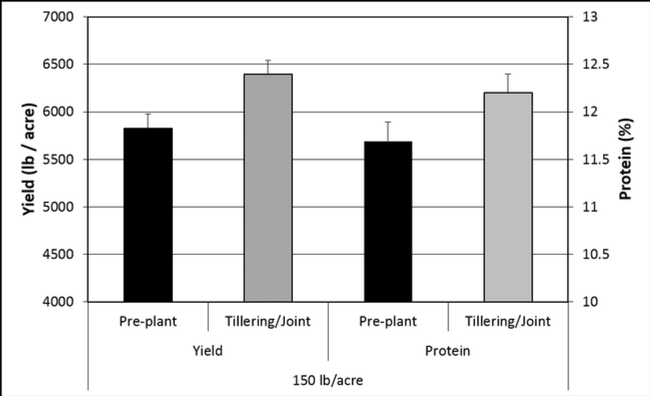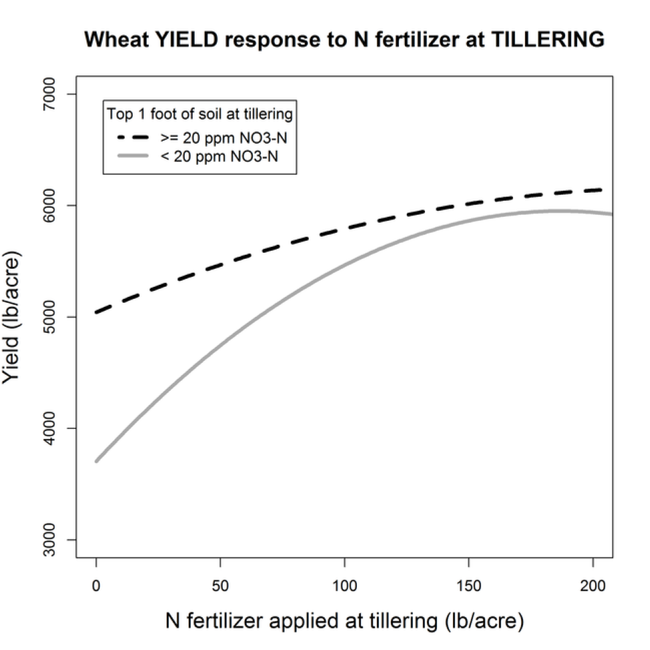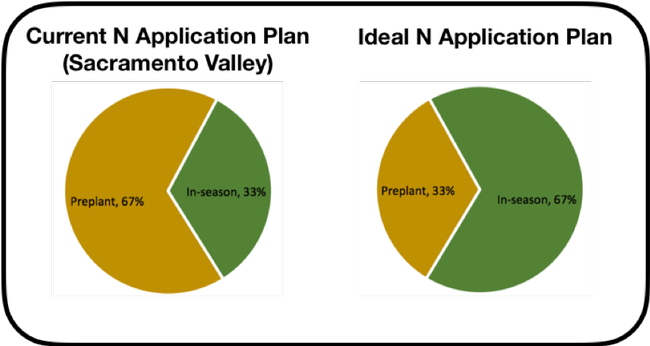Nitrogen budgets are becoming more of a norm for California growers, and more than ever it's important for growers to get the greatest return for their nitrogen applications. One fertilizer management approach that can improve both yield and nitrogen use efficiency is to shift nitrogen applications from being mostly pre-plant to mostly in-season.
Research from the University of California has shown that in-season applications of nitrogen applied from the tillering to the jointing stage resulted in higher wheat yields and grain protein concentrations than pre-plant applications (Figure 1). This is something to keep in mind as we approach the winter growing season.
Figure 1. Effect of 150 lb/acre fertilizer N applied either pre-plant or at the tillering-to-jointing stages of growth on hard spring wheat grain yield and protein concentration. Figure is based on 9 site-years at 3 locations in the Sacramento Valley, the San Joaquin Valley and the Intermountain Region of California.
These results were taken from multiple years of data from both high and low yielding sites. On average, yields in sites where nitrogen was added from the tillering to the jointing stage were 10% higher and grain protein concentration increased by 0.5 percentage points. Furthermore, an even greater yield response to in-season N applications was measured in fields where soil nitrogen levels were below 20 ppm nitrate-N in the top foot of soil compared to those above 20 ppm (Figure 2).
Figure 2. Response of hard spring wheat to varying rates of N fertilizer applied at the tillering-to-jointing stages of growth where soil nitrate-N concentrations in the top 1 foot of soil were either ≥ 20 ppm NO3-N or < 20 ppm NO3-N at the time of application. Note how the gray/solid curve results in greater yield increases to additions of N fertilizer at tillering compared to the black/dotted curve. Figure is based on 7 site-years at 3 locations in the Sacramento Valley, the San Joaquin Valley and the Intermountain Region of California.
Depending on the price of wheat and the expenses associated with in-season applications, growers may want to consider shifting the bulk of their nitrogen fertilizer applications to in-season, leaving only a starter amount for pre-plant applications (Figure 3). There are of course trade-offs associated with in-season applications: rain or irrigation should follow any top-dress applications, fields could be too wet to drive on, and costs of application can be higher. However, aside from being merely a more efficient use of N, this approach also allows for more time to observe the progress of the crop and adjust to growing conditions.
Figure 3. An example of common nitrogen application practices in the Sacramento Valley and a more idealized version where most of the nitrogen (expressed as a percent of a total N budget for the season) is applied in-season at, or shortly after, the tillering stage.
Growers that want to take a more involved approach in additional research can reach out to their local UC Cooperative Extension Farm Advisors. Cooperative Extension will be monitoring the progress of some of these practices using various techniques and field measurements to better improve our understanding the effects application rates and timing. Grower participation would be very helpful in this regard. If you are interested in participating, please contact UCCE before you apply your pre-plant fertilizer.
Yolo, Sacramento, Solano Counties: Konrad Mathesius; kpmathesius@ucanr.edu; 530.218.7567
Sutter, Yuba, Colusa Counties: Sarah Light; selight@ucanr.edu; 530.822.7515
Delta: Michelle Leinfelder-Miles; mmleinfeldermiles@ucanr.edu; 209.953.6100


